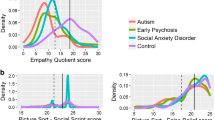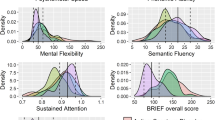Abstract
Young adults with ASD and no intellectual impairment are more likely to exhibit clinical levels of anxiety than typically developing peers (DSM-5, American Psychiatric Association, 2013). This study tests a mechanistic model in which anxiety culminates via emotion dysregulation and social motivation. Adults with ASD (49 males, 20 females) completed self-report measures on emotion regulation, caregivers completed measures on ASD severity and both on social anxiety. Results indicated that emotion dysregulation (p < .001; p < .05) and social motivation (p < .05, p < .001) significantly predicted social anxiety as reported by caregivers and young adults respectively. However, social motivation did not appear to play a moderating role in the relationship between emotion regulation and anxiety, even when controlling for social awareness. Significant predictor variables of social anxiety varied based on reporter (i.e. caregiver versus young adult), with difficulty engaging in goal-directed behaviors during negative emotions serving as the only shared predictor.
Similar content being viewed by others
Notes
Hierarchical linear regression analyses were run to test a possible curvilinear relationship between social motivation and social anxiety and yielded insignificant results.
References
American Psychiatric Association. (2013). Diagnostic and statistical manual of mental disorders (5th ed.). Arlington, VA: American Psychiatric Publishing.
Bagner, D. M., Storch, E. A., & Preston, A. S. (2007). Romantic relational aggression: What about gender? Journal of Family Violence, 22(1), 19–24.
Berthoz, S., & Hill, E. L. (2005). The validity of using self-reports to assess emotion regulation abilities in adults with autism spectrum disorder. European Psychiatry, 20(3), 291–298.
Chevallier, C., Kohls, G., Troiani, V., Brodkin, E. S., & Schultz, R. T. (2012). The social motivation theory of autism. Trends in Cognitive Sciences, 16(4), 231–239.
Cohen, J. (1992). A power primer. Psychological Bulletin, 112, 155–159.
Cohen, J., Cohen, P., West, S. G., & Aiken, L. S. (2003). Applied multiple regression/correlation analysis for the behavioral sciences (3rd ed.). Mahwah, NJ: Lawrence Erlbaum Associates.
Constantino, J. N., & Gruber, C. P. (2005). Social responsiveness scale (SRS). Los Angeles, CA: Western Psychological Services.
Constantino, J. N., & Gruber, C. P. (2012). Social responsiveness scale-second edition (SRS-2). Torrance, CA: Western Psychological Services.
Corbett, B. A., Swain, D. M., Newsom, C., Wang, L., Song, Y., & Edgerton, D. (2014). Biobehavioral profiles of arousal and social motivation in autism spectrum disorders. Journal of Child Psychology and Psychiatry, 55(8), 924–934.
Dalton, K. M., Nacewicz, B. M., Johnstone, T., Schaefer, H. S., Gernsbacher, M. A., Goldsmith, H. H., & Davidson, R. J. (2005). Gaze fixation and the neural circuitry of face processing in autism. Nature Neuroscience, 8(4), 519–526.
Dawson, G., Webb, S. J., & McPartland, J. (2005). Understanding the nature of face processing impairment in autism: Insights from behavioral and electrophysiological studies. Developmental Neuropsychology, 27(3), 403–424.
Dichter, G. S., Felder, J. N., Green, S. R., Rittenberg, A. M., Sasson, N. J., & Bodfish, J. W. (2012). Reward circuitry function in autism spectrum disorders. Social Cognitive and Affective Neuroscience, 7(2), 160–172.
Eack, S. M., Mazefsky, C. A., & Minshew, N. J. (2015). Misinterpretation of facial expressions of emotion in verbal adults with autism spectrum disorder. Autism, 19(3), 308–315.
Frazier, P. A., Tix, A. P., & Barron, K. E. (2004). Testing moderator and mediator effects in counseling psychology research. Journal of Counseling Psychology, 51(1), 115–134.
Garcia-Lopez, L. J., Olivares, J., Beidel, D., Albano, A. M., Turner, S., & Rosa, A. I. (2006). Efficacy of three treatment protocols for adolescents with social anxiety disorder: A 5-year follow-up assessment. Journal of Anxiety Disorders, 20(2), 175–191.
Grant, B. F., Hasin, D. S., Blanco, C., Stinson, F. S., Chou, S. P., Goldstein, R. B., & Huang, B. (2005). The epidemiology of social anxiety disorder in the United States: Results from the National Epidemiologic Survey on alcohol and related conditions. Journal of Clinical Psychiatry, 66(11), 1351–1361.
Gratz, K. L., & Roemer, L. (2004). Multidimensional assessment of emotion regulation and dysregulation: Development, factor structure, and initial validation of the difficulties in emotion regulation scale. Journal of Psychopathology and Behavioral Assessment, 26(1), 41–54.
Hanby, M. S., Fales, J., Nangle, D. W., Serwik, A. K., & Hedrich, U. J. (2012). Social anxiety as a predictor of dating aggression. Journal of Interpersonal Violence, 27(10), 1867–1888.
Hobson, R. P., & Lee, A. (1998). Hello and goodbye: A study of social engagement in autism. Journal of Autism and Developmental Disorders, 28(2), 117–127.
Hudenko, W. J., Stone, W., & Bachorowski, J. A. (2009). Laughter differs in children with autism: An acoustic analysis of laughs produced by children with and without the disorder. Journal of Autism and Developmental Disorders, 39(10), 1392–1400.
Kliemann, D., Dziobek, I., Hatri, A., Baudewig, J., & Heekeren, H. R. (2012). The role of the amygdala in atypical gaze on emotional faces in autism spectrum disorders. The Journal of Neuroscience, 32(28), 9469–9476.
Kohls, G., Schulte-Rüther, M., Nehrkorn, B., Müller, K., Fink, G. R., Kamp-Becker, I., … Konrad, K. (2012). Reward system dysfunction in autism spectrum disorders. Social Cognitive and Affective Neuroscience, 8(5), 565–572.
Konstantareas, M. M., & Stewart, K. (2006). Affect regulation and temperament in children with autism spectrum disorder. Journal of Autism and Developmental Disorders, 36(2), 143–154.
La Greca, A. M., & Lopez, N. (1998). Social anxiety among adolescents: Linkages with peer relations and friendships. Journal of Abnormal Child Psychology, 26(2), 83–94.
Laugeson, E. A., & Frankel, F. (2010). Social skills for teenagers with developmental and autism spectrum disorders: The PEERS treatment manual. New York, NY: Taylor & Francis Group.
Lugnegård, T., Hallerbäck, M. U., & Gillberg, C. (2011). Psychiatric comorbidity in young adults with a clinical diagnosis of Asperger syndrome. Research in Developmental Disabilities, 32(5), 1910–1917.
Mazefsky, C. A., Herrington, J., Siegel, M., Scarpa, A., Maddox, B. B., Scahill, L., & White, S. W. (2013). The role of emotion regulation in autism spectrum disorder. Journal of the American Academy of Child and Adolescent Psychiatry, 52(7), 679–688.
Mazefsky, C. A., Pelphrey, K. A., & Dahl, R. E. (2012). The need for a broader approach to emotion regulation research in autism. Child Development Perspectives, 6(1), 92–97.
Osterling, J. A., Dawson, G., & Munson, J. A. (2002). Early recognition of 1-year-old infants with autism spectrum disorder versus mental retardation. Development and Psychopathology, 14(02), 239–251.
Patriquin, M. A., Scarpa, A., Friedman, B. H., & Porges, S. W. (2013). Respiratory sinus arrhythmia: A marker for positive social functioning and receptive language skills in children with autism spectrum disorders. Developmental Psychobiology, 55(2), 101–112.
Tager-Flusberg, H. (2007). Evaluating the theory-of-mind hypothesis of autism. Current Directions in Psychological Science, 16(6), 311–315.
Tottenham, N., Hertzig, M. E., Gillespie-Lynch, K., Gilhooly, T., Millner, A. J., & Casey, B. J. (2013). Elevated amygdala response to faces and gaze aversion in autism spectrum disorder. Social Cognitive and Affective Neuroscience, 9(1), 106–117.
van Steensel, F. J., Bögels, S. M., & Perrin, S. (2011). Anxiety disorders in children and adolescents with autistic spectrum disorders: A meta-analysis. Clinical Child and Family Psychology Review, 14(3), 302–317.
von Hofsten, C., Uhlig, H., Adell, M., & Kochukhova, O. (2009). How children with autism look at events. Research in Autism Spectrum Disorders, 3(2), 556–569.
White, S. W., Maddox, B. B., & Panneton, R. K. (2014). Fear of negative evaluation influences eye gaze in adolescents with autism spectrum disorder: A pilot study. Journal of Autism and Developmental Disorders, 1–12.
White, S. W., Mazefsky, C. A., Dichter, G. S., Chiu, P. H., Richey, J. A., & Ollendick, T. H. (2014a). Social-cognitive, physiological, and neural mechanisms underlying emotion regulation impairments: Understanding anxiety in autism spectrum disorder. International Journal of Developmental Neuroscience, 39, 22–36.
White, S. W., Schry, A. R., & Kreiser, N. L. (2014b). Social worries and difficulties: Autism and/or social anxiety disorder? In T. E. Davis III, S. W. White, & T. H. Ollendick (Eds.), Handbook of autism and anxiety (pp. 121–136). New York, NY: Springer International Publishing.
Author Contributions
DS cleaned and analyzed the data, wrote the results and discussion sections and synthesized the individual parts. AS contributed primarily to writing. SWW contributed to theory development, data analysis guidance and wrote a portion of the introduction. EL collected the data and contributed to writing the methods section.
Author information
Authors and Affiliations
Corresponding author
Rights and permissions
About this article
Cite this article
Swain, D., Scarpa, A., White, S. et al. Emotion Dysregulation and Anxiety in Adults with ASD: Does Social Motivation Play a Role?. J Autism Dev Disord 45, 3971–3977 (2015). https://doi.org/10.1007/s10803-015-2567-6
Published:
Issue Date:
DOI: https://doi.org/10.1007/s10803-015-2567-6




